
A threshing machine or a thresher is a piece of farm equipment that separates grain seed from the stalks and husks. It does so by beating the plant to make the seeds fall out. Before such machines were developed, threshing was done by hand with flails: such hand threshing was very laborious and time-consuming, taking about one-quarter of agricultural labour by the 18th century. Mechanization of this process removed a substantial amount of drudgery from farm labour. The first threshing machine was invented circa 1786 by the Scottish engineer Andrew Meikle, and the subsequent adoption of such machines was one of the earlier examples of the mechanization of agriculture. During the 19th century, threshers and mechanical reapers and reaper-binders gradually became widespread and made grain production much less laborious.

Winnowing is a process by which chaff is separated from grain. It can also be used to remove pests from stored grain. Winnowing usually follows threshing in grain preparation. In its simplest form, it involves throwing the mixture into the air so that the wind blows away the lighter chaff, while the heavier grains fall back down for recovery. Techniques included using a winnowing fan or using a tool on a pile of harvested grain.

A mortar and pestle is a set of two simple tools used to prepare ingredients or substances by crushing and grinding them into a fine paste or powder in the kitchen, laboratory, and pharmacy. The mortar is characteristically a bowl, typically made of hardwood, metal, ceramic, or hard stone such as granite. The pestle is a blunt, club-shaped object. The substance to be ground, which may be wet or dry, is placed in the mortar where the pestle is pounded, pressed, or rotated into the substance until the desired texture is achieved.

White rice is milled rice that has had its husk, bran, and germ removed. This alters the flavor, texture and appearance of the rice and helps prevent spoilage, extend its storage life, and makes it easier to digest. After milling (hulling), the rice is polished, resulting in a seed with a bright, white, shiny appearance.
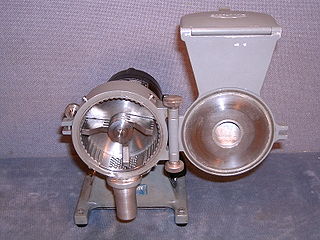
A mill is a device, often a structure, machine or kitchen appliance, that breaks solid materials into smaller pieces by grinding, crushing, or cutting. Such comminution is an important unit operation in many processes. There are many different types of mills and many types of materials processed in them. Historically, mills were powered by hand or by animals, working animal, wind (windmill) or water (watermill). In the modern era, they are usually powered by electricity.

Threshing or thrashing is the process of loosening the edible part of grain from the straw to which it is attached. It is the step in grain preparation after reaping. Threshing does not remove the bran from the grain.
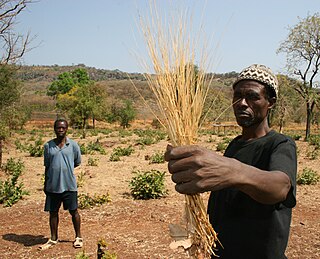
Digitaria exilis, referred to as findi or fundi in areas of Africa, such as The Gambia, with English common names white fonio, fonio millet, and hungry rice or acha rice, is a grass species. It is the most important of a diverse group of wild and domesticated Digitaria species known as fonio that are harvested in the savannas of West Africa. The grains are very small. It has potential to improve nutrition, boost food security, foster rural development and support sustainable use of the land. Despite its valuable characteristics and widespread cultivation, fonio has generally received limited research and development attention, which is also why the species is sometimes referred to as an underutilized crop.

Flattened rice is a preparation of rice made from raw, toasted, or parboiled rice grains pounded into flat flakes. It is traditional to many rice-cultivating cultures in Southeast Asia and South Asia. It is also known as rice flakes, beaten rice, pounded rice, pressed rice or chipped rice.

Rice hulls or husks are the hard protecting coverings of grains of rice. In addition to protecting rice during the growing season, rice hulls can be put to use as building material, fertilizer, insulation material, or fuel. Rice hulls are part of the chaff of the rice.

Broken rice is fragments of rice grains, broken in the field, during drying, during transport, or during milling. Mechanical separators are used to separate the broken grains from the whole grains and sort them by size.

Roller mills are mills that use cylindrical rollers, either in opposing pairs or against flat plates, to crush or grind various materials, such as grain, ore, gravel, plastic, and others. Roller grain mills are an alternative to traditional millstone arrangements in gristmills. Roller mills for rock complement other types of mills, such as ball mills and hammermills, in such industries as the mining and processing of ore and construction aggregate; cement milling; and recycling.

Evaristo Conrado Engelberg was a Brazilian mechanical engineer and inventor. He is the inventor of the Engelberg huller, a machine used to strip the husks from rice and coffee during harvest. He was born to German immigrants in Piracicaba, São Paulo.
The Engelberg Huller Company was established in 1888 in Syracuse, New York, by John R. Montague, to manufacture and distribute the Engelberg Huller machine which was invented by Brazilian mechanical engineer and inventor, Evaristo Conrado Engelberg, and Willard Halstead to remove the husks and shells from rice and coffee during the milling process.
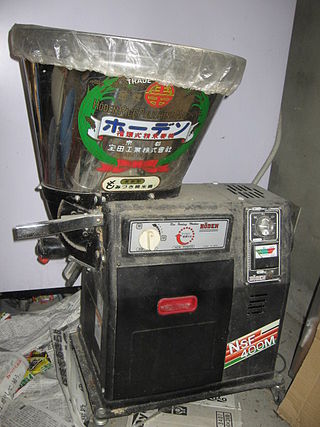
A rice polisher is a machine for buffing kernels of rice to change their appearance, taste, and texture or for transforming brown rice into white rice.

Color sorters or color sorters are machines used on production lines in bulk food processing and other industries. They sort items by color, detecting passing items' colors and using mechanical or pneumatic devices to divert items with colors outside the acceptable range or to create distinct groups.
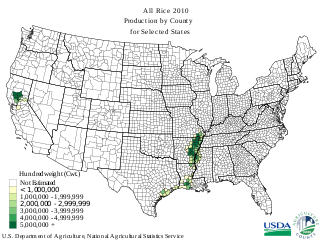
Rice production is the fourth largest among cereals in the United States, after corn, wheat, and sorghum. Of the country's row crop farms, rice farms are the most capital-intensive and have the highest national land rental rate average. In the United States, all rice acreage requires irrigation. In 2000–09, approximately 3.1 million acres in the United States were under rice production; an increase was expected over the next decade, to approximately 3.3 million acres. USA Rice represents rice producers in the six largest rice-producing states of Arkansas, California, Louisiana, Mississippi, Missouri, and Texas.
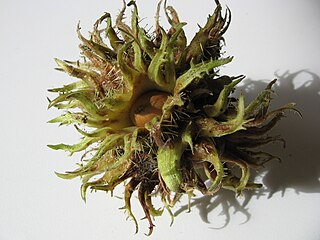
Husk in botany is the outer shell or coating of a seed. In the United States, the term husk often refers to the leafy outer covering of an ear of maize (corn) as it grows on the plant. Literally, a husk or hull includes the protective outer covering of a seed, fruit, or vegetable.
The Imota rice mill is an agricultural plant in Ikorodu, a suburb of Lagos, Nigeria. It was built in 2021 and was inaugurated in 2023 with the commencement of full production.



















